Five Questions for Adam Wright, UCLA Men’s and Women’s Water Polo Coach
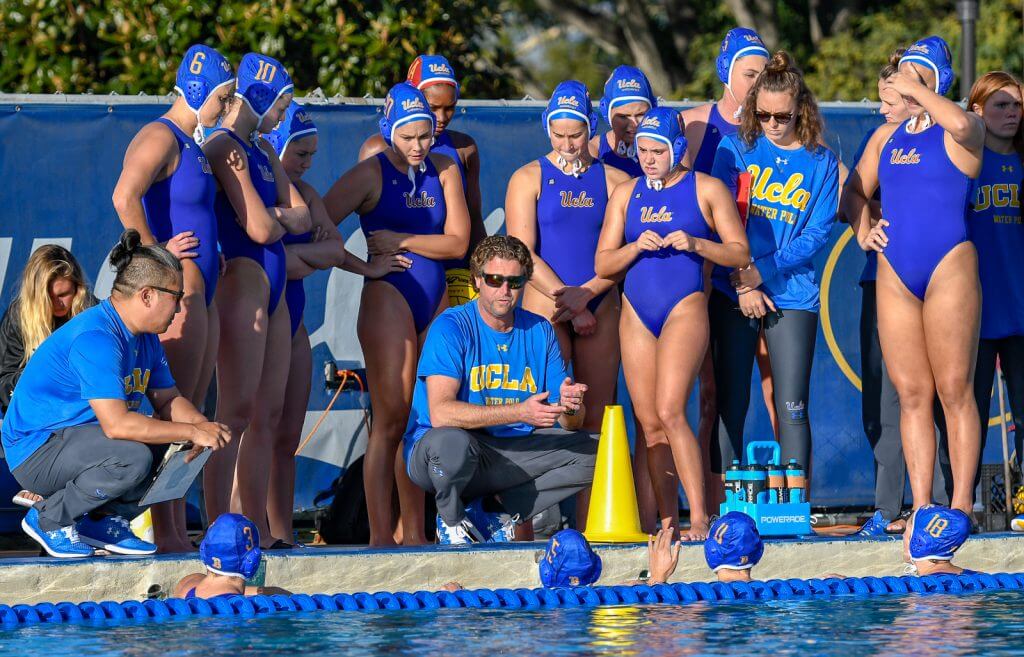
Adam Wright is one of America’s best coaches, and his approach to his UCLA men’s and women’s teams, as well as the health of the sport in the U.S., is both frank and refreshing.

Much has been written about his career playing for the U.S. Senior Men’s National Team—participating in three Olympics, and a member of the 2008 squad that made a thrilling run to the gold medal match in the Beijing Games before falling to the dynastic Hungarians.
What must also be considered is how much of Wright’s legacy is defined by his connection to UCLA. A member of back-to-back NCAA champions as a player (1999, 2000), at the conclusion of his playing career he returned to Westwood and joined Adam Krikorian’s staff for what was the last of an impressive five-straight women’s national championships (2005-2009). An assistant to the Bruin men, it was a natural next step for Wright to assume leadership of UCLA in 2009, in the midst of USC’s epic run of six straight men’s titles. Fittingly, it was Wright’s Bruins that ended the Trojan’s reign with a 9-8 victory in 2014—a feat UCLA repeated in 2015 as the culmination of an undefeated season (30-0).
Following a third championship in four years (2017), Wright became head coach for the UCLA women, the first dual program coach in Westwood since Krikorian. Last season—when the Bruins finished behind USC and Stanford—was a process of re-learning the women’s game and re-affirming core UCLA values.
Coach Wright recently spoke with Swimming World about a return to coaching the Bruin women, the value UCLA puts on being decisive on defense, and a pool of NCAA contenders crowded by Cardinals, Trojans and other MPSF rivals.
– It’s Year Two for you coaching the Bruin women. What was surprising from last year and what has now become old hat?
In 2009, my first year back to UCLA, I was an assistant to Adam [Krikorian] for both the men and the women. That year on the women’s side was when they won their fifth straight national championship. What I didn’t remember was the length of the season. Where it differs greatly from the men’s [is] the men’s season is a sprint. From the very first week, a result can be the difference of everything.
That was a big thing because there’s a limited amount of time in big games on the men’s side to develop your roster. You can develop them throughout the year with trainings but there’s just certain moments where that development phase is gone for certain players. That’s one piece that does exist on the women’s side. You have a chance to really get all your players out there, especially early on in the season, which is important.
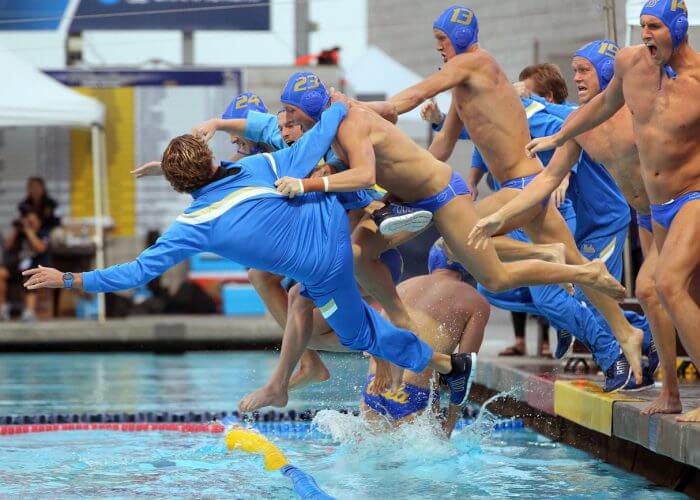
Everyone in the pool! UCLA wins in 2015. Photo Courtesy: UCLA Athletics
All athletes are at different levels and you want every athlete in your program to invest to the best of their ability. At the core of it, every athlete wants to play. How the schedule lays out for the women’s season affords that.
Another big piece is adjustment—we really take great pride in taking care of the physical training and keeping our kids healthy, and who we’re going to have an opportunity to really ramp it up at certain points in the season. That was new. There was a lot of learning through the first season.
Also mentally, which we’re heavily invested in. In the women’s season they have to go through finals, they have to come back from holiday break, they go through spring break. There’s a lot of different factors where it can be mentally fatiguing, so it’s easy to lose focus.
For me those were the biggest learning curves that I had forgotten about.
– Suffocating defense has always been the hallmark of UCLA polo, but your system cannot be implemented over night. How much better prepared will your team be to play your style in 2019?
Every coach is a product of where they played and who they played for. From all of my coaches, we were always told at a young age: what wins championships? Defense. I really believe in that. The Warriors and what they’re doing in basketball is very interesting, but at the core of it when they’re locked in you can see how they play defense.
If you’re a fundamentally sound defensive team—even if you’re great at offense and it’s your worst offensive day—you’re going to have a chance. And that’s all you want. Now, maybe if you’re not as offensively gifted as your opponents, you have to find ways and make adjustments. But if you get in a high-scoring game, the chances of you being successful are not very good. So you’d better be really damn good at defense.
As we’re into year two, where we are now as opposed to where we were last year is a completely different place. We’ve been able to establish where we want to go with our culture, how we communicate with each other. The standard with which we train, including little details—all the way down to how many breast kicks you’re supposed to take or where your legs are supposed to be positioned. And that takes time.
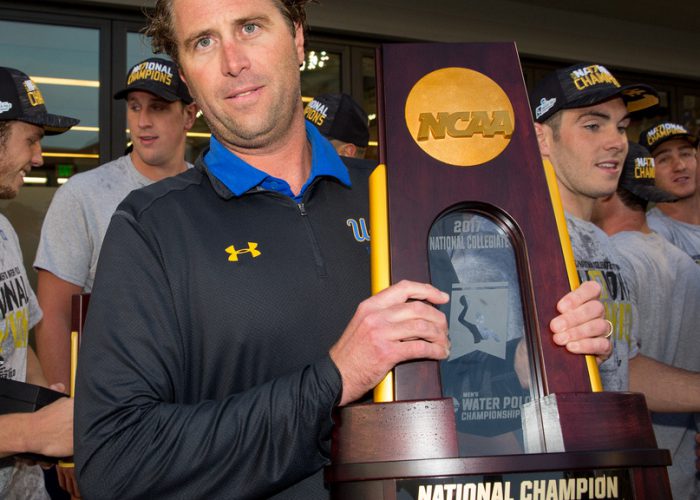
Wright hoisting hardware in 2017. Photo Courtesy: Catharyn Hayne
The reality is, that stuff is starting to be set in stone. The nice part is that, over time, it starts to organically grow within the team. The team is enforcing it by the way everybody trains. Meaning, you see your teammates doing it a certain way, you’d better do it that way. Otherwise, you’re going to stick out.
Of course, we have to hold a standard. But it doesn’t have to come from me or the other coaches all the time. That’s the evolution that we need.
I will say, we have a long ways to go. But to have a foundation in place, for the team to understand just how important it is to be fundamentally sound from a body position standpoint to an awareness standpoint for defense…. We have come a long ways. And it’s going to serve us well as we move into the future.
– Maddie Musselman was injured just when your team needed her most—for MPSF and NCAAs. What’s her status and what might be expected after almost a year off from playing?
She has been out for an extended period. She’s playing now—she played today (UCLA win last Saturday over UC Irvine). Maddie’s back and she’s put in the work. Obviously, there’s a progression any time you’re out of the water for an extended period.
Are we better served with Maddie in the water for us? Absolutely! Her experiences with the national team, she does so many little things that people don’t know about; releasing, getting live balls to the center. She’s demonstrated she can be one of the top scorers in the world. But the small things that she does on the defensive end as well as the offensive end are what change our team.
You have to understand a player who was the youngest on the national team in her first Olympic Games, surrounded by such great players. Then on to UCLA where two years ago we obviously had a really strong team with a large graduation group. Then a coaching change.
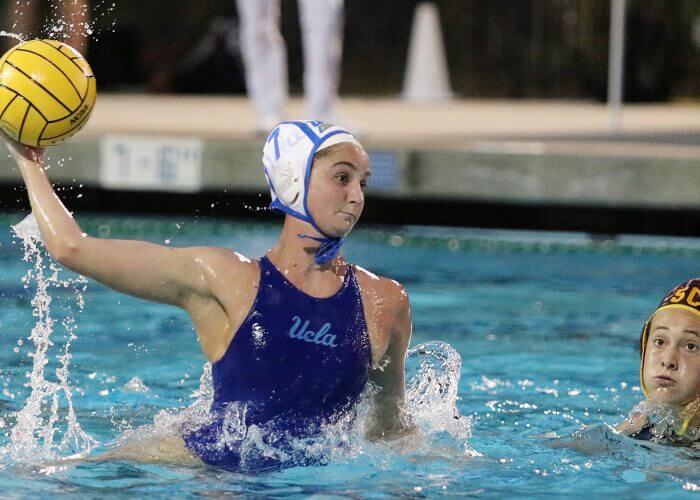
Maddie Musselman back to doing what she does best. Photo Courtesy: Richard Quinton
There’s times when she’s completely open but the ball won’t arrive—those are things that are frustrating. [But] she doesn’t change the way she trains or her attitude. It’s a big test—both mental and physical—when you’ve been out of the water as she was. The nice part is she’s had a great progression back, she played her first game against Irvine, she’s going in a good way. And a lot of times a break can serve an athlete [well]. It can allow you to recharge and work on some deficiencies that you may have physically. I believe this is a case of that. it’s a reminder to everyone that a sporting career can be over quickly—even at a young age.
Somebody’s health is my top priority—over success. She truly is a special player, she was special before she got to UCLA. She’s going to keep evolving [and] we’re lucky to have her. My goal is to continue to surround her with players who have the same level of commitment to the team, to training—and we’re doing that. We have a great young core of girls in here, we have a returning group.
Last year was tough—and I’m not naïve. It was difficult for all those girls. They worked their butts off, and I believe they maximized their time together. We fell short but it wasn’t for a lack of effort. Sometimes for athletes who have been playing at a high level, that can be challenging and frustrating. The biggest testament is that she stayed true to it.
– Given that Stanford and the defending NCAA champions Trojans return very strong teams, how do you see the season evolving for the Bruins?
I don’t think there’s any secret that those two programs over the course of the last nine – ten years have had a stronghold (on NCAA titles). And both those teams have reloaded again. They have a lot of experience—and experience is really important.
We have a great opportunity; our ceiling to grow is maybe higher than theirs, in certain ways. Not in experience; not the same level of players from top to bottom or the same number of positional players.
The biggest challenge for UCLA women’s water polo is on us. If we don’t create the right environment at UCLA every day for training, then we aren’t going to arrive at the team that we ultimately need to be. You’ve got to be ready to go every day. Hopefully we can create an environment similar to the challenge we face with [Stanford and USC]; but that’s difficult. We have a lot of young players, we don’t have that same experience at crunch time.
We’re going to have to find some ways from a playing standpoint to find more offense and we’re going to have to be damn good on defense. These are things as I coach that I know we can sit here and say it’s a long season, but we can’t afford to let days go by.
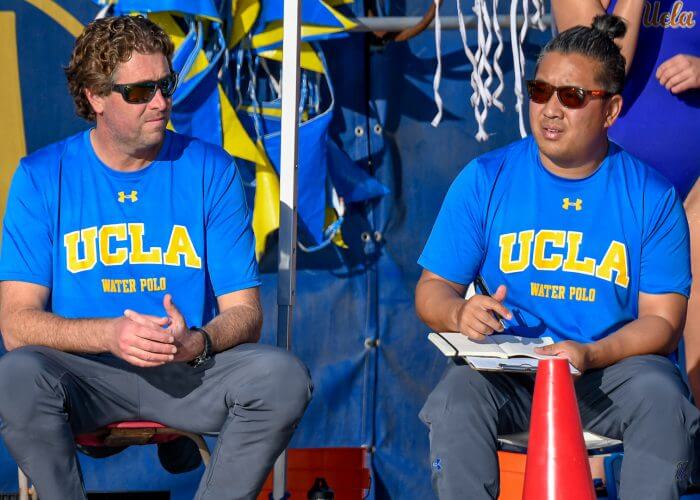
Adam Wright, Chris Lee. Photo Courtesy: Minette Rubin
That’s pure honesty and the same that I told our team. And I feel it is important to know how the we treat things when we’re together—whether we’re on the road here in Santa Barbara or when we’re together at home. Because that is the absolute only way we have a chance to win. Those are damn good teams and we want to be competitive with them all the time.
I really like this team [and] I like where we’re going off of last year’s team. We have great new additions and a motivated group. We have a long way to go but a great opportunity to grow. That’s a fact. But we have to maximize those opportunities. If we don’t then it will be really tough.
– Indiana has taken the bold step of changing conferences to join the MPSF—arguably the world’s strongest women’s league. What do you think of the Hoosiers’ decision?
I’m only into year two, and I can only reflect back to 2009 from a women’s side standpoint. [The year] the NCAA championship was at Maryland. It’s a shame that program is gone [eliminated in 2012]. What a great facility they have!
What I do remember most being back for a year, it’s really incredible how many institutions have water polo. You have to understand, prior to last year I’m looking at it exclusively from a men’s coaching standpoint. Something interesting there is, I always wondered why the Indiana’s and the Michigan’s don’t have a men’s water polo team, but it’s women’s water polo that has traversed our country. To have a university like Indiana have women’s water polo and support it the way they do.
What a great opportunity to open more doors for more women players. And we need that. There’s so many people playing water polo, especially young women. And what a special opportunity to attend a university like Indiana.
At the same time, I’m sure it was a big decision and a big jump, because for us selfishly it really helps our conference. We’re adding another team to strengthen our numbers.
Ryan and Indiana had to take a real look at it because they could probably challenge for the East [if they stayed in the CWPA]. What I understand is he felt this would give more exposure to Indiana water polo. And look, they’re out here in Santa Barbara on the first weekend.
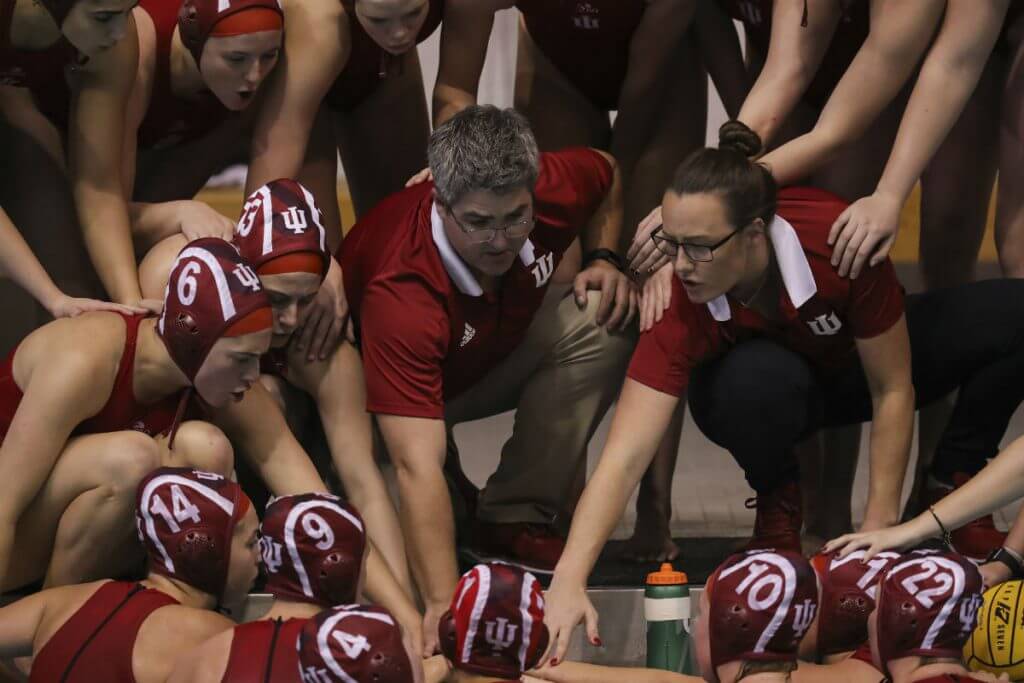
Head Coach Ryan Castle and his Hoosiers. Photo Courtesy: Indiana Athletics
There’s a lot of girls playing and there’s only so many spots at so many schools. If Ryan starts getting some of these girls [to Indiana] then it was a brilliant move [because] it opens the door for his recruiting world.
Is it going to challenging? Of course. You gotta ride it out, because they clearly had a real reason to do this. They’re going to get more exposure to high-level games. They’re going to be a part of the strongest tournament every year—even more so than maybe the NCAA tournament.
There’s always risk when you make change. But at the same time, I expect it was a well thought out decision. Let’s see over the next three – four years how it effects their recruiting, but also the experience their teams are getting, and how that plays out with the teams [in the East].
That could change things. You see all these new conferences being formed—be it football or water polo—and teams jumping conference to conference. Say they become very strong in the next three – four years, with players looking to go to Indiana. Maybe they make a [conference change] and they’re the team to beat.



